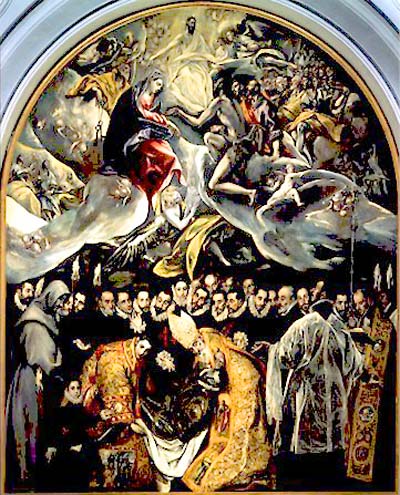
The narrow cobblestone streets criss-crossed the city like they had a mind of their own--some twisting and turning their way for what seemed to be miles, others stopping after 30 feet or so.


Our tour guide said it would take at least three days to really experience Toledo (and I'd love to go back sometime in the next four months) but he'd show us the highlights. We first visited the main Catedral in the city.


While I was amazed by both the size of the cathedral and all of the intricate craftsmanship (painting, sculpting, wood-working), our guía Luis said that the church's collection of paintings is its real claim to fame. Even with my limited knowledge of art, the 20 or so paintings hanging in the priests' dressing room blew my mind--some of them so life-like you half expected them to start walking and talking a la Harry Potter. No pictures were allowed inside (although I tried to take some undercover video that didn't turn out very well) so I posted some from Google.


Next up was a visit to the main synagogue, which was transformed into a Catholic church as a result of the Spanish Inquisition. Now, it's back to how it looked before--a synagogue in appearance but now only used as a museum. Not quite as breathtakingly beautiful as the Cathedral but pretty in its own way and an important reminder of Toledo's history.

Finally, we visited a much smaller church to see El Greco's masterpiece, The Burial of the Count of Orgaz. Painted on a giant canvas, the 15 ft by 11.7 ft piece of art tells the story of a man who has recently died. He is on the bottom of the painting surrounded by a group of church officials--including representations of El Greco himself and his son. The top half of the painting reflects the fact that while he may have died in this world, new life is awaiting him in heaven. Jesus is surrounded by angels and saints in the top half of the painting and the man's spirit is passing from one world to the next. Again, no pictures allowed, so Google to the rescue.

We then spent the rest of the afternoon walking through the streets, doing a little shopping, and eating a delicious lunch at a restaurant overlooking the city. The food in Spain, by the way, has been excellent. Both my señora and my señor are excellent cooks and we've already sampled some fancy restaurants on the program's dime (which really is my parent's dime, but whose keeping track, right Mom and Dad?)

Don Quixote and Sancho Panza

Toledo is also famous for its long history of sword making.

At the town market, you can read about who has died in the last week and when their funerals will be held.

Pots and pans, hanging outside the window. Thought it was interesting. All in all, a grand day in Toledo. That's it for now. Hasta luego, mis amigos.
No comments:
Post a Comment